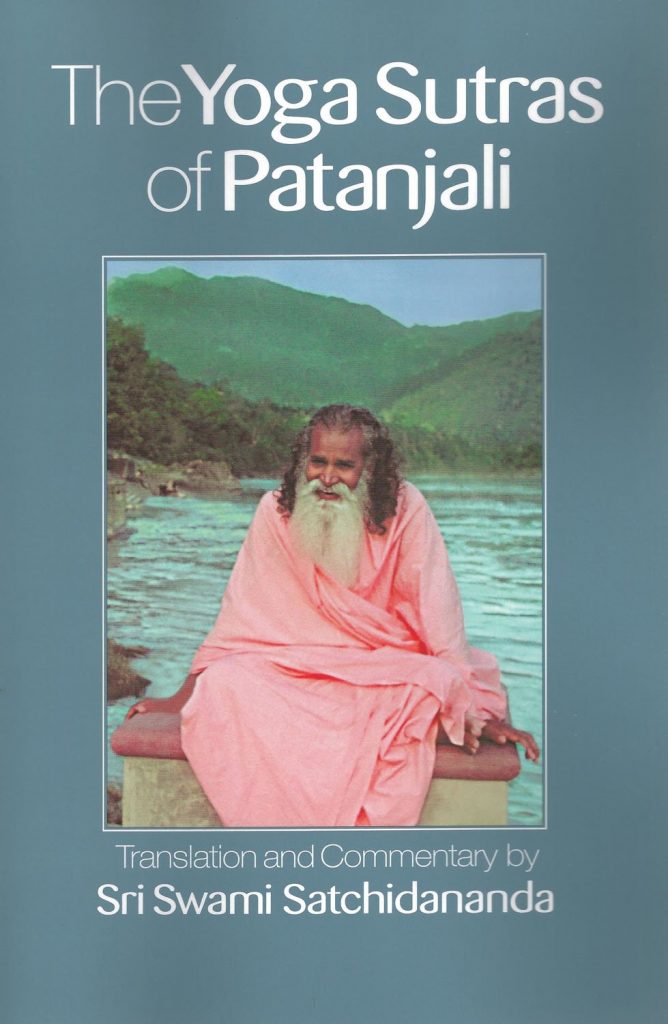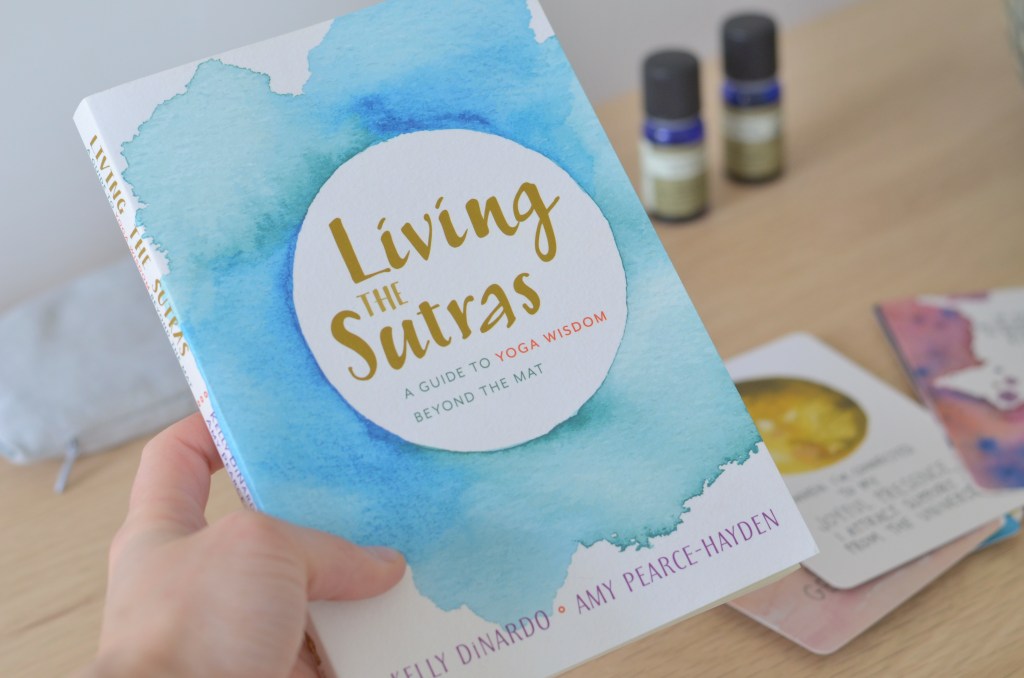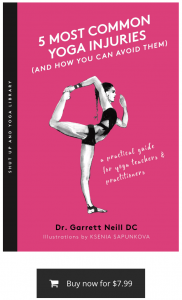If yoga was solely about postures, then gymnasts and Cirque du Soleil performers would be amongst the most enlightened people in the word.
When I first picked up Living the Sutras by Kelly DiNardo and Amy Pearce-Hayden, I was a little skeptical. Personally, I’m not the biggest fan of self-help books, so I was dubious as to what this book could possibly offer me in regards to the sutras of Patanjali. I was previously under the strong assumption that ancient spirituality didn’t necessarily go hand-in-hand with modern self-help, but boy was I wrong!
Living The Sutras provides a contemporary look at applying the sutras of Patanjali and how they can be adapted for our day-to-day lives.

However, before I go any further, I want to answer two questions those of you who are less familiar with the Yoga Sutras may have…
What exactly is a sutra?
A sutra is an ancient aphorism or poetic phrase which allows the reader (or listener, depending on how you intake the information) to come away with some profound wisdom from its simple wording. For example, a sutra could be as straightforward as, “fires burn bright, even if not attended,” or as direct as, “now, the practice of yoga begins.” In both cases, we can take these sorts of phases literally—of course, a fire would burn bright on its own because fires burn on their own and they’re bright, or, ok, let’s start some yoga! However, the true beauty of a sutra is that its applications are limitless. When looking at each sutra as more of an analogy or application to events, one could also interpret the example sutras as, “the light inside me will always be there shining bright, even if I don’t feel it, and I can come to it whenever I need,” or “the time of ‘now’ is the practice of yoga because yoga is about bringing oneself into the now.” As you can see, there are levels to each sutra’s understanding and, in turn, application and appreciation. And this is only one example; the possible interpretations are endless.
Who the heck is Patanjali?
Well, to start, it’s unclear if Patanjali was a singular person, like a Buddha or a Jesus, or a collection of teachings formulated by a series of individuals who called themselves Patanjali. That’s not something I’ll be examining here, as I am neither a historian or an anthropologist, I just know that Patanjali (the person or the group) was a highly influential figure and contributor to the practice of yoga.

Did Patanjali invent yoga? No, yoga existed long before the rise of Patanjali; he (or they) simply took yoga’s primary teachings and principles and consolidated them into a systematic method.
This is actually quite similar to how Buddha was initially a Hindu and later developed his own path (or ‘way’) by adapting the teachings he had previously learned in Hinduism; ultimately creating something more direct and ‘to the point’.
Now, the book analysis begins.
As I mentioned in the intro, I surprised myself and ended up really enjoying Living the Sutras. But why?
I really appreciated how applicable it is to daily life. The book is filled with instances in which we can check ourselves, alongside various practices and exercises that we can engage in to help merge knowledge with direct experience. I have to give it to the authors, they definitely know what they’re talking about and are adept at getting their point across!
Perhaps the two biggest takeaways from this book are to start to see yourself beyond your identified self, a teaching I try to champion in my own daily life, as well as the understanding that, all life is a celebration, we’ve just been at the party so long we’ve come to forget it! This second philosophy has become a personal mantra of mine and is something I strive to remember whenever I feel the drudging gnaw of mundane existence, or am overwhelmed by stressors which start to rear their ugly head.
Whether you’re angry at the impeding traffic on your drive home from work, or feeling irritated by something your co-worker said to you at lunch, the idea here is to see beyond your own identified state and ask yourself, “What is really going on here?”
By seeing beyond yourself and realizing that your co-worker may just be having a bad day, or that the inundating traffic is not the end of the world, you can slowly let go of your attachment to the outcome and just flow and allow what is happening to happen. You are simply the passenger (no pun intended) watching the world around you go by. It is what it is—so, accept it, move on, and enjoy the show.
That’s all well and good, but what about when life starts to get a little boring or burdensome; where everything seems to be a monotonous deja vu experience, and life is starting to feel like it’s lacking in its lustre? Remember that your experience is the gift. By coming fully into this moment, finding contentment, and showing gratitude for your experiences, you will once again find the vitality and enjoyment that you were seeking. It’s not the goal, the status, or the accomplishments that make life worth living; it’s the journey of getting to your destination.
Life is filled with more small victories than big ones, and if you get bogged down by only waiting for the big victories to come, your life will have far fewer moments of wonder and appreciation than someone who found the grand within the small.
This is it. This is your experience. Enjoy the ride while it lasts.
Why is this book so great?
The unique thing about this book is the way it approaches and applies the sutras of Patanjali to our daily lives. Throughout each section (section, because the book isn’t broken up into individual chapters; rather, individual ideas) the authors take a broad concept (such as “Antidotes” or “The Approach”) and extrapolate them using references, teachings and aphorisms directly taken from Patanjali. Then, at the end of each section, the reader is presented with a “Reflection.” These Reflections are thoughtful questions and exercises which you can take part in, so as to combine the theoretical knowledge that you had just learned with direct experience; ultimately, affording wisdom.
This is the primary reason why I attest that the authors of this book did a brilliant job in conveying and relating Patanjali’s teachings to the general public. The only way to truly know something—to integrate it into our daily lives—is to first examine it, then experience it within ourselves. This is what the authors have allowed the reader to do.
How can I use this book?
So, how best can we use this book? Well, there are a few ways to read the book. First, and most common, is to read the book front to back. This way, you are afforded a holistic view of the entire subject matter and can return to a particular section during a time that you may need some guidance or life advice. Alternately, you can skim the section titles and see which one directly resonates to you most in that moment. Each section is forwarded with a thought-provoking header which may speak directly to you, according to what you may need at that time.
For example, the section “A Matter Of Perspective” may draw you in when you’re having a rough day and need a new way of looking at things. Fitting to its title, the section is all about how what you had gone through previously has helped you get to where you are today; along with a Reflection exercise asking you to think about a negative experience you once had, which ended up shaping you in a positive way.
Hence, whether you read the entire book front to back, or pick out sections that resonate with you in that moment, the answers and exercises are both clear and relatable; affording you both the counsel and guidance that you are undoubtedly seeking.

What can I expect?
What someone will no doubt find within this book’s pages is perennial wisdom. General truths and expansive perspectives on life, which will all help to reshape and reframe your overall life experience. Something that is considered trite is only viewed in that way because it is true.
No matter how much we think “we already knew that,” we all need reminders. This book is exactly that. A reminder of truth, or unspoken wisdom, which we all innately know within ourselves but have yet to articulate fully in mind. This book helps lay the cobblestones on the path for us to walk.
In summary, this is definitely a book that you’ll want to have on your Yogi’s Bookshelf; you will inevitably find yourself picking it up from time to time whenever you feel lost or in need of a quick morale or mental boost!
Sutras and lessons are everywhere, and wonder and excitement are all around you. The only question left to ask is: can you, yourself, still see it?
You can find Living the Sutras: A Guide to Yoga Wisdom Beyond the Mat on Shambala Publications and Amazon.
Edited by Sarah Dittmore



